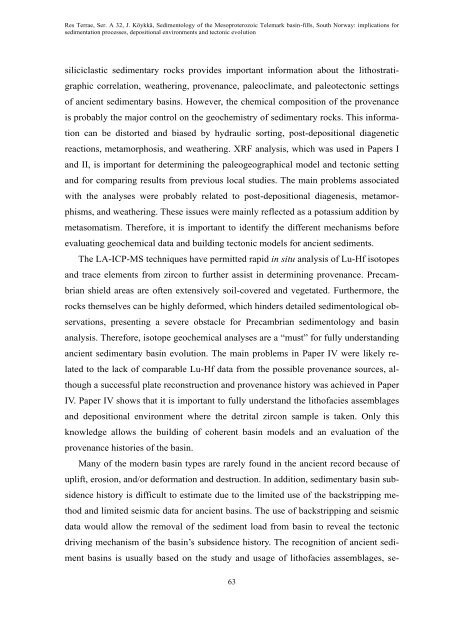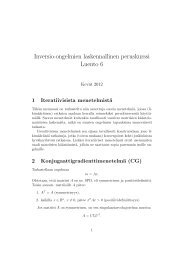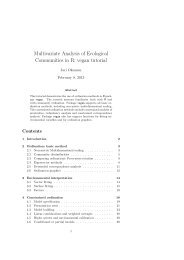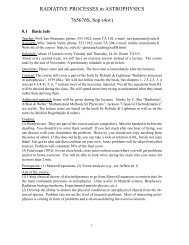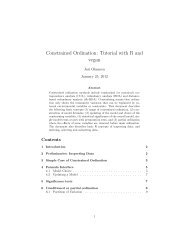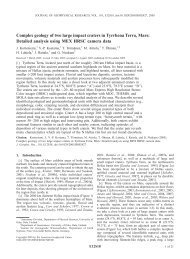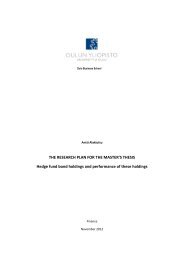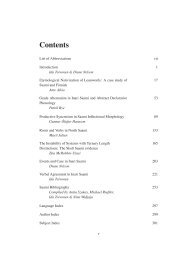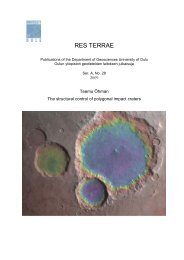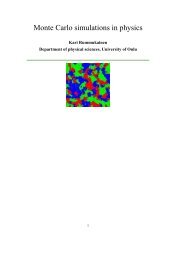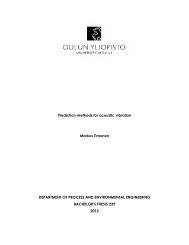Juha Köykkä - Oulu
Juha Köykkä - Oulu
Juha Köykkä - Oulu
- TAGS
- juha
- oulu
- cc.oulu.fi
Create successful ePaper yourself
Turn your PDF publications into a flip-book with our unique Google optimized e-Paper software.
Res Terrae, Ser. A 32, J. <strong>Köykkä</strong>, Sedimentology of the Mesoproterozoic Telemark basin-fills, South Norway: implications for<br />
sedimentation processes, depositional environments and tectonic evolution<br />
siliciclastic sedimentary rocks provides important information about the lithostrati-<br />
graphic correlation, weathering, provenance, paleoclimate, and paleotectonic settings<br />
of ancient sedimentary basins. However, the chemical composition of the provenance<br />
is probably the major control on the geochemistry of sedimentary rocks. This informa-<br />
tion can be distorted and biased by hydraulic sorting, post-depositional diagenetic<br />
reactions, metamorphosis, and weathering. XRF analysis, which was used in Papers I<br />
and II, is important for determining the paleogeographical model and tectonic setting<br />
and for comparing results from previous local studies. The main problems associated<br />
with the analyses were probably related to post-depositional diagenesis, metamor-<br />
phisms, and weathering. These issues were mainly reflected as a potassium addition by<br />
metasomatism. Therefore, it is important to identify the different mechanisms before<br />
evaluating geochemical data and building tectonic models for ancient sediments.<br />
The LA-ICP-MS techniques have permitted rapid in situ analysis of Lu-Hf isotopes<br />
and trace elements from zircon to further assist in determining provenance. Precam-<br />
brian shield areas are often extensively soil-covered and vegetated. Furthermore, the<br />
rocks themselves can be highly deformed, which hinders detailed sedimentological ob-<br />
servations, presenting a severe obstacle for Precambrian sedimentology and basin<br />
analysis. Therefore, isotope geochemical analyses are a “must” for fully understanding<br />
ancient sedimentary basin evolution. The main problems in Paper IV were likely re-<br />
lated to the lack of comparable Lu-Hf data from the possible provenance sources, al-<br />
though a successful plate reconstruction and provenance history was achieved in Paper<br />
IV. Paper IV shows that it is important to fully understand the lithofacies assemblages<br />
and depositional environment where the detrital zircon sample is taken. Only this<br />
knowledge allows the building of coherent basin models and an evaluation of the<br />
provenance histories of the basin.<br />
Many of the modern basin types are rarely found in the ancient record because of<br />
uplift, erosion, and/or deformation and destruction. In addition, sedimentary basin sub-<br />
sidence history is difficult to estimate due to the limited use of the backstripping me-<br />
thod and limited seismic data for ancient basins. The use of backstripping and seismic<br />
data would allow the removal of the sediment load from basin to reveal the tectonic<br />
driving mechanism of the basin’s subsidence history. The recognition of ancient sedi-<br />
ment basins is usually based on the study and usage of lithofacies assemblages, se-<br />
63


